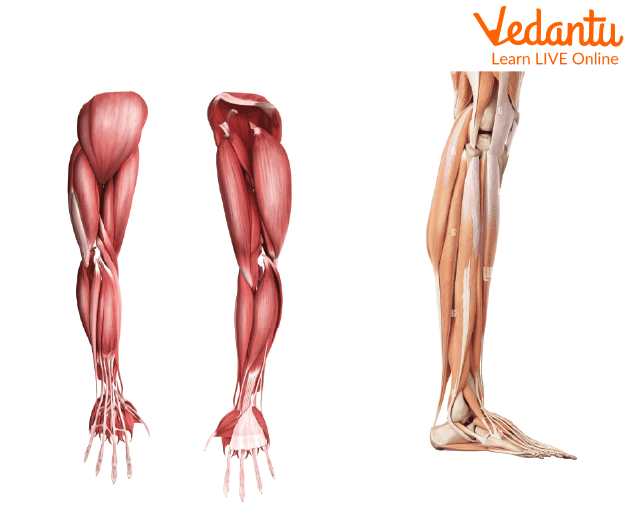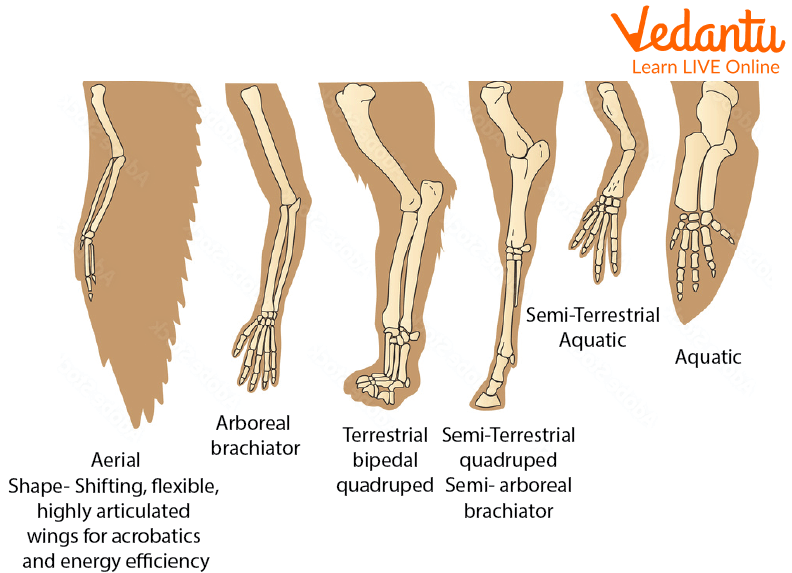




An Introduction to Limbs of Animals
Limbs are defined as jointed appendages of a human or other animal’s body. Animals have legs(lower limbs) which acts as a support system and bears all the weight of the body and most importantly helps them to perform various locomotive activities. Humans have two legs while other mammals such as dogs, cats have four legs; the frontal ones are called fore legs while back ones are called hind legs. Insects have 3 to 200 pairs of legs whilst birds only have 2 hind legs and instead of forelegs they have wings which helps them to fly.

Limbs
Various Types of Limbs:

Various Types of Limbs
In the human body there are two kinds of limbs, Upper limbs and Lower limbs. Two Upper limbs are called arms while two lower limbs are called arms. Animals like horses have only four lower limbs, frontal ones are fore legs whilst back ones are hind legs. Insects also have lower limbs called legs whose pair ranges from 3 to 200. Birds have two lower limbs and in place of upper limbs they have two wings that help them to fly on higher altitudes.
What is the Structure of Human Limbs?
Human body’s upper and lower limbs consist of elements of the shoulder and hip girdles. The arms and legs are connected by the torso. Moreover if we restrict ourselves with legs then all the mammals have the same structure, A knee joins the upper and lower portion of each leg, At the bottom of each leg there is a foot along with muscles which overall makes our body move. While if we talk about arms then arms are weak but very mobile in nature because of this they can reach at a wide range of angles and distances in order to grasp or manipulate the objects.
Interesting Facts about Limbs:
The bones of the human leg consist of basal segment, femur, tibia, fibula and foot.
First artificial/prosthetic limb was made by a French surgeon Ambroise Pare in 1579.
Most prosthetic wears are created using titanium, aluminium and carbon fibers.
The oldest prosthetic wear was found in the year 2000 in the city of cairo. It was a prosthetic toe made of wood and leather dated back 3000 years.
Currently there are 2.1 million people living without a limb.
Sample Questions:
1. What are limbs? List their functions.
Ans. Limbs are jointed appendages present in all the animals since their birth, limbs act as a support system for the body which helps to perform various physical tasks like locomotion- running, climbing, walking, climbing, grasping, holding and even writing.
2. Describe the structure of human limbs.
Ans. Human body has 4 limbs in total, in which 2 are upper limbs and other 2 are lower limbs.upper and lower limbs consist of elements of the shoulder and hip girdles. A knee joints the upper and lower segment of each lower limb while an elbow joints the upper and lower segment of each upper limb.
3. Does birds have upper limbs?
Ans. Yes, birds have upper limbs. But they are not like human upper limbs, their upper limbs are evolved into wings which help them to fly at high altitudes.
Conclusion:
Limbs are a very important part of any animal body, various physical survival activities of animals depend on limbs. If a person lacks a limb either by natural or accidental cause, it becomes really difficult for him to survive with normal citizens, they are considered different from normal people and are called as disabled people. Nowadays science has evolved to some extent such that these limbical disabilities can be avoided by using artificial/prosthetic wear which adds to the body like an actual limb.
FAQs on Limbs of Animals
1. What are limbs in animals?
Limbs are body parts like arms, legs, wings, or flippers that extend from an animal's main body. Animals use them for movement, such as walking, flying, or swimming, and for interacting with their environment.
2. What are the main functions of an animal's limbs?
An animal's limbs serve several important functions, helping them survive and thrive. Key functions include:
- Movement: To walk, run, hop, climb, swim, or fly.
- Support: To hold up the body's weight and maintain balance.
- Interaction: To hold food, dig burrows, build nests, or defend themselves from predators.
- Sensing: To feel and explore their surroundings.
3. How many limbs do humans have and what are they called?
Humans have four limbs in total. We have two upper limbs, which we call arms, and two lower limbs, which we call legs. Our arms are used for reaching, grasping, and holding objects, while our legs are primarily used for walking, running, and providing support.
4. Do all animals have limbs?
No, not all animals have limbs. For example, animals like snakes, earthworms, and most types of snails do not have any limbs. They have developed other ways to move, such as slithering their entire body or crawling on a muscular foot.
5. Are a bird's wings and a fish's fins considered limbs?
Yes, these are special types of limbs that are adapted for specific environments. A bird's wings are modified forelimbs (similar to arms) that are designed for flying. Similarly, a fish's fins and a whale's flippers are limbs perfectly adapted for steering and moving through water.
6. How many limbs do common animals like dogs, cats, and cows have?
Common mammals such as dogs, cats, cows, and horses all have four limbs, which are all legs. The two front legs are called forelegs, and the two back legs are called hindlegs. They use all four for walking and running.
7. How many legs do insects have?
Most insects, such as ants, bees, and beetles, have six legs. These legs are attached to the middle part of their body, the thorax. They provide excellent stability, allowing insects to walk, climb, and grip surfaces with great agility.
8. Why do different animals have different types of limbs?
Animals have different kinds of limbs because each type is specialised for the animal's habitat and way of life. This is a result of adaptation. For instance, a monkey has long arms for swinging through trees, a cheetah has powerful legs for running on land, and a duck has webbed feet for paddling in water.
9. Can an animal have an odd number of limbs, like five?
Yes, some marine animals are known for having an odd number of limbs. The most common example is a starfish, which typically has five arms radiating from a central point. It uses these arm-like limbs to move slowly along the ocean floor and to hold onto its food.
10. Which animals are known for having a large number of limbs?
Some animals have many more than four limbs. For example, crabs and lobsters are decapods, which means they have ten limbs (eight walking legs and two claws). Other creatures like centipedes and millipedes have even more, possessing dozens or even hundreds of legs that help them move efficiently.









